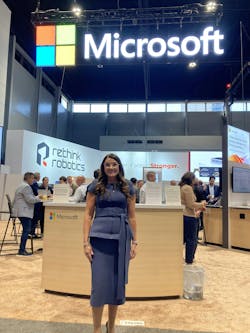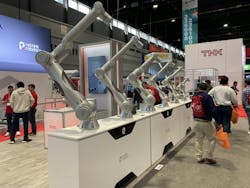Maintenance Mindset: Forget humans. Meet the new materials that can sense, compute, and power themselves
Welcome to Maintenance Mindset, our editors’ takes on things going on in the worlds of manufacturing and asset management that deserve some extra attention. This will appear regularly in the Member’s Only section of the site.
Imagine there’s no computers; it isn’t hard to do
Manufacturing has long been in search of lights-out autonomous operations, zipping along 24/7 without human interaction. Machines and robots working in concert, and data analytics harmonizing production optimization and equipment criticality and failures. But compute power requirements are increasing as quickly as electronic components are shrinking, and it’s hard to keep up. Imagine a world where a material itself can sense, compute, communicate and create its own energy, much like the human brain, independent of external hardware and software.
It’s a world called mechanical metamaterial electronics or meta-mechanotronics, and it’s not science fiction. It’s the real world of Amir Alavi, assistant professor of civil and environmental engineering at the University of Pittsburgh Swanson School of Engineering.
Earlier this year, Alavi received a Faculty Early Career Development (CAREER) Award from the National Science Foundation. The five-year $535,120 award will fund his project: Mechanical Metamaterial Electronics: Theory, Design and Applications.
"We’re creating a 3D-printed material that is, itself, a computing system," said Alavi. "It could be used on so many scales. Manned missions to Mars, for example, require complementary electronics made of materials that can withstand harsh, unforgiving environments, created on the spot for specific purposes. The same material could, at a smaller scale, create a cardiac implant that can diagnose and monitor health conditions where we can’t use bulky electronics."
Alavi has been researching mechanical metamaterials and energy harvesting for some time, introducing his initial work on self-aware materials in 2021. His other previous work has introduced self-powered, self-sensing concrete; and smart implants that can monitor healing. Now, Alavi and the Intelligent Structural Monitoring and Response Testing (iSMART) Lab at the University of Pittsburgh have designed a new metamaterial that can sense, record and relay information about the pressure and stresses on the structure. It generates its own energy and could be used in a wide range of sensing and monitoring applications.
How does this new class of intelligent materials work? According to researchers, under pressure and between the material’s conductive and dielectric layers, an electric charge is created by contact-electrification (or a fundamental part of triboelectricity). The charge relays information about material condition and is powered by a built-in triboelectric nanogenerator mechanism, capable of harnessing hundreds of watts at large scale.
“There is no doubt that the next generation materials need to be multifunctional, adaptive and tunable,” said Alavi. “You can’t achieve these features with natural materials alone—you need hybrid or composite material systems in which each constituent layer offers its own functionality. The self-aware metamaterial systems that we’ve invented can offer these characteristics by fusing advanced metamaterial and energy harvesting technologies at multiscale, whether it’s a medical stent, shock absorber or an airplane wing.”
Self-sensing materials do already exist, as different forms of carbon fibers that act as sensing modules. In addition to opening material accessibility, this newest work aims to bring sensor and nanogenerator materials into a working system. The new field of meta-mechanotronics will be a platform for intelligent matter that operates in its own closed-loop control system, dynamic and self-adjusting.
Scalability is one intriguing aspect, with applications working at both nano- and mega scale. And the material applications are wide open, aiming to turn a broad range of organic and inorganic materials into an intelligent system, as a heart stent to self-monitor blood flow or a mechanically tunable bridge beam that could self-monitor for structural defects. With low density materials, light in mass, low in cost and highly scalable, its developers see it as ideal for future space exploration.
Imagine the manufacturing applications for such materials in robotics, human-machine interfacing, machine predictive maintenance and flexible, small electronics. Imagine how scalable, self-aware materials could change how we manufacture and what we manufacture.
You may say I’m a dreamer, but I’m not the only one. Imagine there’s no people. It’s easy if you try.
– Anna Townshend
IMTS 2024 recap: CMMS and cloud providers stake out their positions in the world of machine tooling
This week I stopped in on the largest manufacturing technology trade show in North America, the International Manufacturing Technology Show, or IMTS. The show brings every type of machine and technology that might be useful in a plant to Chicago's McCormick Place, with an emphasis on machine tooling and metal cutting.
Because these machines are often large and delicate, with a wide variety of failure modes, IMTS has been attracting a segment of the CMMS industry which sees an opportunity to help machine shops get a better handle on their asset management strategies. This year, I had the chance to speak with Brightly’s Corey Dickens, Limble’s Bryan Christiansen, and MaintainX’s Nick Haase (and I wasn’t able to get to the Upkeep booth this year, sorry Ryan!) as well as several maintenance and operations managers who were reaping benefits from their recent CMMS implementations.
One thing that several people mentioned is that these medium-sized CMMS systems are catching on due to their intuitive mobile interface, as the developers are paying at least as much attention to the mobile user experience as to the functionality of the software. This app-first approach is paying off in a key way: as one maintenance manager told me, his most senior frontline worker (64 years old) was as comfortable with the CMMS app as his most junior workers, and that immediate comfort level helped drive adoption across his entire team. With change management being the toughest hurdle to new software adoption, any factor that makes change easier on the team is a considerable win.
Speaking of software, the big three cloud providers – Google, AWS, and Microsoft – each had massive booth space at IMTS this year, and each wanted to focus on one theme: moving AI past the hype to improve production, supply chain, and frontline workforce processes. This focus on AI was somewhat new for IMTS, but it fit in with the message being sent by the CMMS providers: your data are valuable, and best in class manufacturers need to figure out how to move, store, combine, and process data sets in order to drive new business value.
I say “somewhat” because CNC machinists have been using machine learning for a long time to improve tooling processes. However, the conversation among the IMTS crowd has definitely moved forward to encompass ways to leverage operational data to make a difference beyond operations.
– Thomas Wilk






